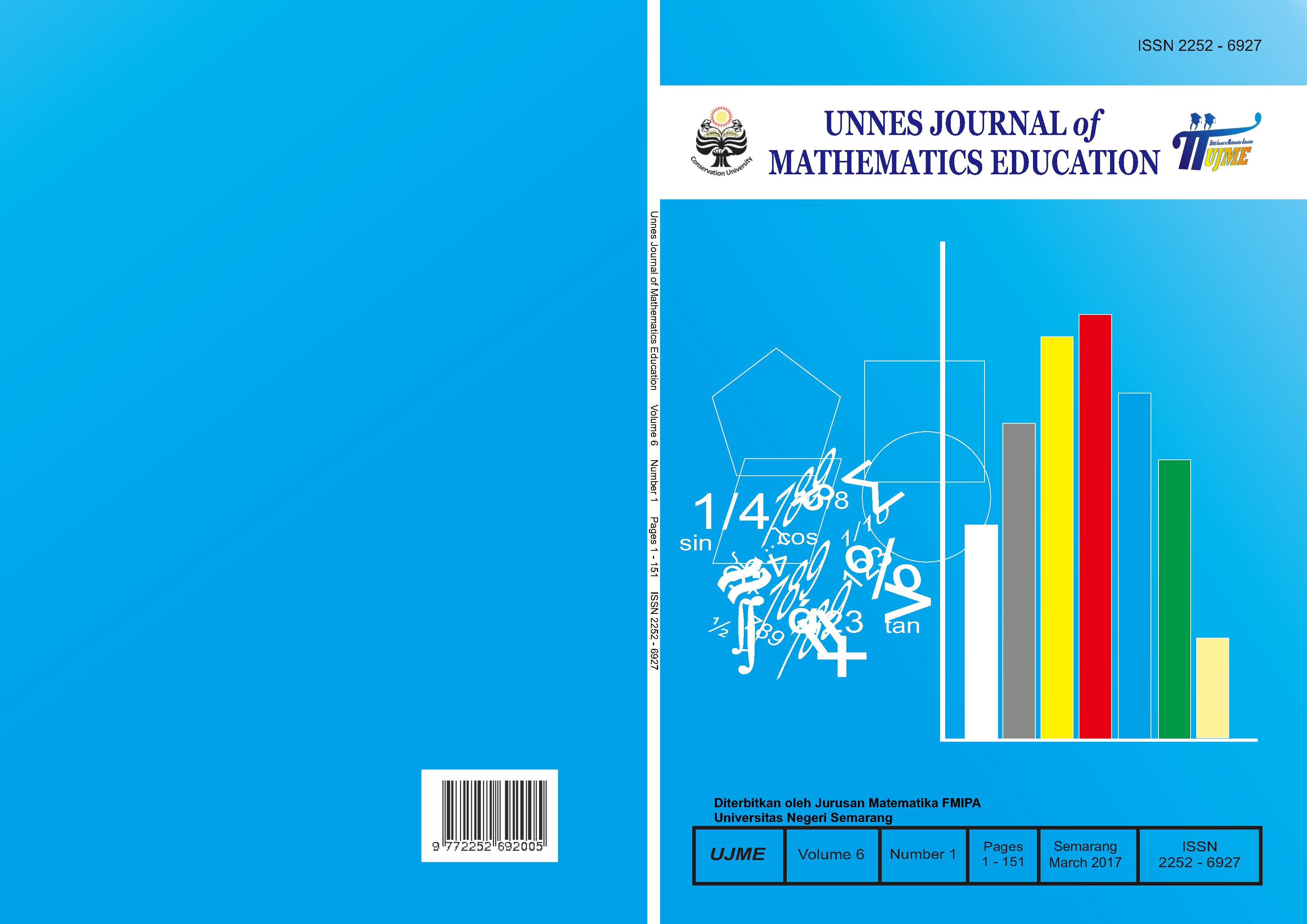Analysis of Mathematical Communication Skills Viewed from Student Learning Styles in Eighth Grader Students in Learning Resource Based Learning Model Analisis Kemampuan Komunikasi Matematis Ditinjau dari Gaya Belajar Siswa Kelas VIII pada Model Pembelajaran Resource Based Learning Section Articles
##plugins.themes.academic_pro.article.main##
Abstract
Tujuan penelitian ini adalah untuk mengetahui kemampuan komunikasi matematis siswa pada model resource based learning berdasarkan ketuntasan dan gaya belajar. Gaya belajar yang dimaksud adalah gaya belajar visual, auditorial dan kinestetik. Metode penelitian yang digunakan adalah mixed methode, dengan squential explanatory desain. Populasi dalam penelitian ini adalah siswa kelas VIII SMP 1 Jekulo dan pengambilan sampel dilakukan dengan random sampling. Sampelnya adalah kelas VIII-E dan subjek penelitian dipilih dengan teknik purposive, diperoleh 6 subjek yang terbagi untuk tiap gaya belajar. Hasil penelitian menunjukkan bahwa (1) kemampuan komunikasi matematis siswa dengan model pembelajaran resource based learning mencapai ketuntasan klasikal, (2) kemampuan komunikasi matematis siswa dengan gaya belajar visual dapat dikategorikan dalam tingkat pencapaian 4, (3) kemampuan komunikasi matematis siswa dengan gaya belajar auditorial dapat dikategorikan dalam tingkat pencapaian 4,(4) kemampuan komunikasi matematis siswa dengan gaya belajar kinestetik dapat dikategorikan dalam tingkat pencapaian 3.
The purpose of this research was to know the students ability of mathematical communication on a learning with resource based learning model that is based on the criteria of completeness and the learning styles. These learning style are visual, auditory and kinesthetic. This research used a mixed methods, and squential explanatory design. The population of this reseacrh are students of VIII grade SMP 1 Jekulo and the sample was taken by random sampling. The sample was VIIIÂE class and subjects were selected by purposive, it was obtained 6 subjects that divided in each learning styles. The results showed that (1) the ability of mathematical communication students with resource based learning model achieved classical completeness, (2) the students ability of mathematical communication with a visual learning style can be categorized in the fourth level of achievement,(3) the students ability of mathematical communication with learning styles auditory can be categorized in the fourth level of achievement, (4) the students ability of mathematical communication with kinesthetic learning style can be categorized in the third level of achievement.
##plugins.themes.academic_pro.article.details##
References
Asikin, M. & Junaedi, I. 2013. Kemampuan Komunikasi Matematika Siswa SMP dalam Setting Pembelajaran RME (Realistic Mathematics Education). Unnes Journal of Mathematics Education Research, 2(1): 204-213.
Butler, M. 2012. Resource-Based Learning and Course Design: A Brief Theoretical Overview and Practical Suggestions. Law Library Journal, Vol.2 No.104, hal.219-244.
DePorter, B & Hernacki. M. (2015). Quantum Learning. Bandung : Kaifa. Fathurrohman, M. 2015. ModelÂmodel Pembelajaran Inovatif. Jogjakarta: ArRuzz Media.
Fujiati, I., & Mastur, Z. (2014). Keefektifan Model Pogil Berbantuan Etnomatematika Terhadap Kemampuan Komunikasi Matematis. Unnes Journal of Mathematics Education, (3) 3.
Hannafin, J., & Hill. R. (2007). Resource Based Learning. Hand book on research in educational communication. Georgia: University of Georgia
Moussa, N. (2014). The Importance of Learning Styles in Education. International Journal of Education, Vol.1, No.2, hal.19-27.
Moleong, L.J. (2010). Metodologi Penelitian Kualitatif. Bandung: PT. Remaja Rosdakarya.
NCTM. (2000). Principles and Standards for School Mathematics. USA: NCTM.
Ozbas, S. (2013). The Investigation of the Learning Styles of University Students. The Online Journal of New Horizons in Education. Vol.3, Issue.1.
Qohar, A. (2011). Mathematical Communication: What And How To Develop It In Mathematics Learning?. Proceeding of International Seminar and the Fourth National Conference on Mathematics Education 2011.
Sumarmo. (2006). Pembelajaran Keterampilan Membaca Pada Sekolah Menengah. Bandung: FPMIPA UPI.
Tiffani, H. (2015). Profil Proses Berpikir Siswa Smp Dalam Menyelesaikan Soal Perbandingan Berdasarkan Gaya Belajar Dan Gaya Kognitif. Jurnal Kependidikan Dasar, Vol.1 No.1.
